Lessico
Leda
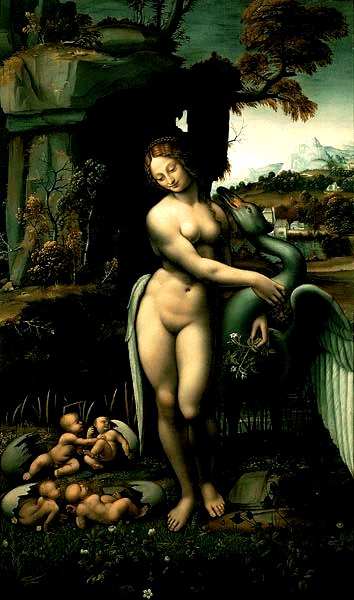
Leda
e il Cigno - 1510 circa
di Leonardo da Vinci
(Vinci, Firenze, 1452 - castello di Cloux, presso Amboise, 1519)
olio su tavola - Galleria degli Uffizi - Firenze
Uno dei
miti che il mondo greco ci ha trasmesso, e che oltre a un particolare fascino
racchiude future belligeranze protratte, è quello di Leda. Leda sposò
Tindaro re di Sparta![]() . Ed ecco entrare in scena un uccello, spesso simbolo di
fecondità, tant'è che anche lo Spirito Santo viene raffigurato nella vesti
di una candida colomba.
. Ed ecco entrare in scena un uccello, spesso simbolo di
fecondità, tant'è che anche lo Spirito Santo viene raffigurato nella vesti
di una candida colomba.
L'uccello
di Leda è un cigno - forse perché la bellissima figlia di Testio re
d’Etolia voleva sperimentarlo anche a cavatappi![]() - sotto le cui spoglie si è
intrufolato il sommo Zeus
- sotto le cui spoglie si è
intrufolato il sommo Zeus![]() .
Zeus - cioè il cigno - giace con Leda e dal sollazzo ne sbuca un uovo dal
quale - non si sa incubato da chi e se per nove mesi o meno - nacquero Elena
.
Zeus - cioè il cigno - giace con Leda e dal sollazzo ne sbuca un uovo dal
quale - non si sa incubato da chi e se per nove mesi o meno - nacquero Elena![]() e Pollùce
e Pollùce![]() , uno dei due Dioscuri.
, uno dei due Dioscuri.
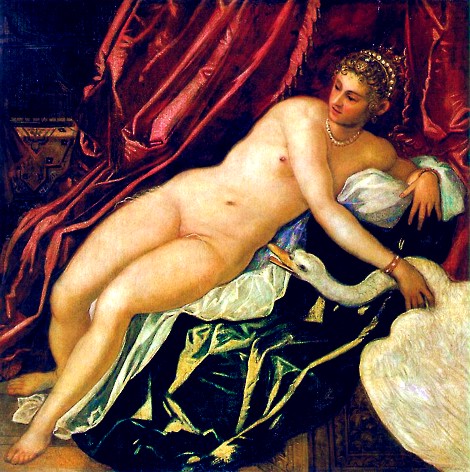
Leda
e il Cigno – 1570/1575
di Domenico Robusti detto il Tintoretto (Venezia 1560-1635)
dipinto conservato nella Galleria degli Uffizi a Firenze
Castore e Polluce
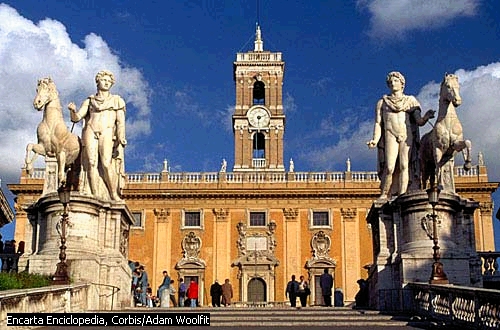
Statue
dei Dioscuri
Roma
Collocate alla sommità della scalinata del Campidoglio durante il pontificato di Sisto V (1585-1590), le statue dei Dioscuri risalgono alla metà del II secolo dC, quando furono scolpite probabilmente per il tempio dedicato ai due semidei nel Circo Flaminio. Rinvenute in frammenti nel 1560 circa, furono identificate come simulacri dei gemelli Castore e Polluce dall'antiquario e architetto Pirro Ligorio, quindi restaurate.
Castore, l'altro Diòscuro (cioè il giovane, il ragazzo, il figlio di Zeus che al genitivo fa Diós), forse anche lui nacque da un secondo uovo generato grazie al cigno, ma coloro che non vogliono un Tindaro tanto cornuto dicono che Castore era figlio del re, il quale si era presa la rivincita appena dopo Giove.
Da questo secondo uovo, insieme a Castore, nacque anche
Clitennestra, poi sposa dello sfortunato Agamennone re di Micene, sfortunato e
cornuto sì, ma un po’ se l’era voluta: pur di partire per Troia![]() aveva sacrificato agli dei la figlia Ifigenia, e Clitennestra, essendone la
madre, questa malefatta proprio non la perdonò al marito, anche se era il
capo della spedizione greca contro Troia.
aveva sacrificato agli dei la figlia Ifigenia, e Clitennestra, essendone la
madre, questa malefatta proprio non la perdonò al marito, anche se era il
capo della spedizione greca contro Troia.
A parte le corna e gli intrallazzi amorosi di Leda tramandati in altre versioni che è futile disquisire, i Dioscuri andavano sempre in coppia: Castore giù a domar cavalli, Polluce giù a dar pugni a dritta e a manca in quanto eccelleva nel pugilato.
Elena
invece aveva sposato Menelao![]() ,
anch'egli re di Sparta, ma un bel giorno fuggì con Paride e la guerra di
Troia ne fu il prolisso epilogo durato quasi nove anni.
,
anch'egli re di Sparta, ma un bel giorno fuggì con Paride e la guerra di
Troia ne fu il prolisso epilogo durato quasi nove anni.
Comincio a dubitare che l'uovo sia sempre e in ogni caso foriero di avvenimenti gioiosi!
I gemelli, che non si separavano mai, parteciparono alla spedizione degli Argonauti, poi fecero guerra agli Ateniesi per riavere la sorella Elena, che era stata rapita giovanissima da Teseo. In seguito, innamorati delle due figlie di Leucippo e di Arsinoe, combatterono i figli di Afareo, Linceo e Idas, ai quali le fanciulle erano state promesse.
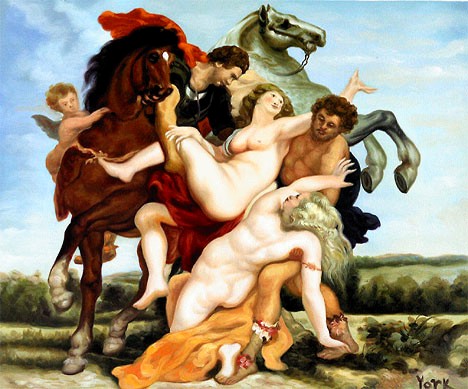
Ratto
delle figlie di Leucippo – 1618
Pieter Paul Rubens (Siegen, Vestfalia, 1577 - Anversa 1640)
Nel duello
Castore venne ucciso da Linceo, che fu poi ucciso da Polluce, mentre Idas perì
sotto il fulmine di Zeus. Affranto per la morte del fratello, Polluce chiese
al suo padre divino di dividerne la sorte. Allora Zeus concesse loro di vivere
a turno un giorno nell’Olimpo e un giorno nell’Ade![]() . Questo scambio continuò
finché il re dell’Olimpo non trasformò entrambi nella costellazione dei
Gemelli. In loro onore si celebravano a Sparta e ad Atene le feste Dioscurie.
Successivamente queste feste ebbero luogo anche a Roma, per ricordare
l’apparizione dei Gemelli divini al lago Regillo, dove avrebbero partecipato
alla battaglia a fianco dei Romani.
. Questo scambio continuò
finché il re dell’Olimpo non trasformò entrambi nella costellazione dei
Gemelli. In loro onore si celebravano a Sparta e ad Atene le feste Dioscurie.
Successivamente queste feste ebbero luogo anche a Roma, per ricordare
l’apparizione dei Gemelli divini al lago Regillo, dove avrebbero partecipato
alla battaglia a fianco dei Romani.
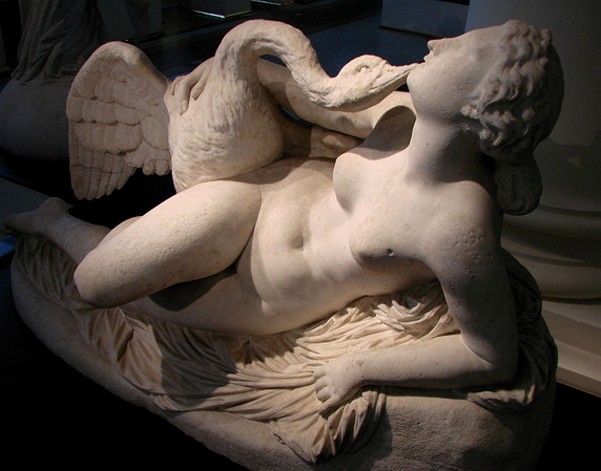
In Greek mythology, Leda (Λήδα) was daughter of the Aetolian king Thestius, and wife of the king Tyndareus(Τυνδάρεως), of Sparta. Her myth gave rise to the popular motif in Renaissance and later art of Leda and the Swan. She was the mother of Helen (Ἑλένη) of Troy, Clytemnestra (Κλυταιμνήστρα), and Castor and Pollux (Κάστωρ & Πολυδεύκης, spelled Kastor and Polydeuces).
Leda was admired by Zeus, who seduced her in the guise of a swan. As a swan, Zeus fell into her arms for protection from a pursuing eagle. Their consummation, on the same night as Leda lay with her husband Tyndareus, resulted in two eggs from which hatched Helen — later known as the beautiful "Helen of Troy" — Clytemnestra, and Castor and Pollux (also known as the Dioscuri (Διόσκουροι). Which children are the progeny of Tyndareus, the mortal king, and which are of Zeus, and are thus half-immortal, is not consistent among accounts, nor is which child hatched from which egg. The split is almost always half mortal, half divine, although the pairings do not always reflect the children's heritage pairings. Castor and Polydeuces are sometimes both mortal, sometimes both divine. One consistent point is that if only one of them is immortal, it is Polydeuces.
In Homer's Iliad, Helen looks down from the walls of Troy and wonders why she does not see her brothers among the Achaeans. The narrator remarks that they are both already dead and buried back in their homeland of Lacedaemon, thus suggesting that at least in some early traditions, both were mortal. Leda also had other daughters by Tyndareus: Timandra (Τιμάνδρα), Phoebe (Φοίβη), and Philonoe (Φιλονόη). Another account of the myth states that Nemesis (Νέμεσις) was the mother of Helen, and was also impregnated by Zeus in the guise of a swan. A shepherd found the egg and gave it to Leda, who carefully kept it in a chest until the egg hatched. When the egg hatched, Leda adopted Helen as her daughter. Zeus also commemorated the birth of Helen by creating the constellation Cygnus (Κύκνος), the Swan, in the sky. Leda and the swan and Leda and the egg were popular subjects in the ancient art. In the postclassical arts, it became a potent source of inspiration.
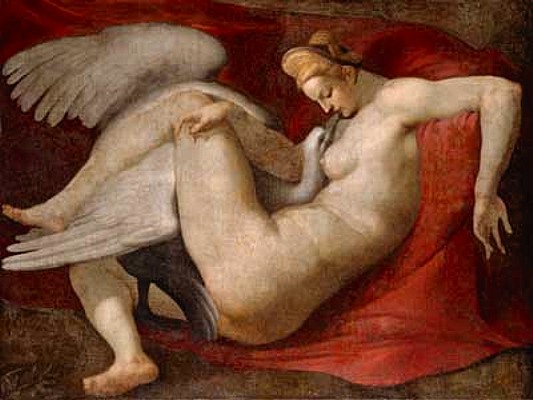
Leda
and the Swan
16th-century copy after the lost painting by Michelangelo